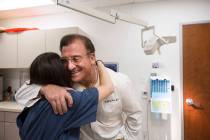Need for Pepto not going away
Chances are better than good that you or someone in your family has already suffered from it. It really doesn’t surprise you all that much when it happens –– cramps, diarrhea, vomiting.
You keep Pepto-Bismol in the medicine cabinet to deal with it. Grandma, who learned a thing or two in her years of the trots and throwing up, may well have told you not to eat anything more than bananas, rice, applesauce and toast until it’s over.
Let’s be honest: Food poisoning, or foodborne illness, is as American as apple pie. According to the FDA, more than 16 percent of Americans, about 48 million of us, suffer from it every year.
As you walk in the office after an off day of dealing with it, everyone nods when you say you ate something “bad” and starts to share his or her own tale of woe.
It’s obviously not the kind of war story you hear down at the VFW, but the cynical camaraderie experienced after someone has a bout with food bacteria is very real, as though everyone knows that only lip service can or will be paid when it comes to food safety.
Our society, despite a current attempt at regulatory change after outbreaks of salmonella and E. coli and listeria, appears to have accepted, albeit reluctantly, the notion that suffering, and sometimes death, is an additional price you may have to pay for food.
It’s hard not to come to that conclusion when the FDA proudly trumpets that the Food Safety Modernization Act that Congress passed in 2010 could mean a 4 percent reduction in cases of what the agency calls “largely preventable” foodborne illness.
Doesn’t that still translate to, at best, 46 million sick Americans upchucking and downloading bad food every year?
Is the promise of short-term profit driving food industry middlemen, largely unafraid of discovery, to knowingly ship tainted product?
That cynical view of the food industry is not shared either by 15-year-old Rylee Gustafson of Henderson or her mother, Kathleen Chrismer, who basically believe ignorance of safety by food workers causes most foodborne illness.
In 2006, Rylee ate a spinach salad in Nevada that made her sick during a trip to California. She became one of the 130,000 people hospitalized each year with foodborne illness, and only masterful work by doctors kept her from being one of the more than 3,000 that annually die from it. Because of an E. coli infection, Rylee’s pancreas failed and she’s now diabetic. Her kidneys also shut down and she faces a kidney transplant by age 30.
“I think the 2010 law can make a big difference,” said Rylee, who sat with her mother in their Henderson home and talked about her recent testimony in Oregon before FDA officials who are finalizing rules for the 2010 law, the first major changes to food safety laws since the 1930s.
“Rylee puts a human face on the problem,” said Chrismer, who has become a board member of Stop Foodborne Illness, a national nonprofit lobbying group for food safety, since her daughter’s illness.
As incredible as it may seem, only with the passage of the new law has the FDA gotten the power to recall contaminated food without relying on voluntary action by industry. The law governs 80 percent of the U.S. food supply, everything but meat and poultry, which is inspected by the USDA. The new rules require that: Farmers ensure irrigation water that touches fruits and vegetables isn’t contaminated; the water used to wash fruits and vegetables in packing sheds must be clean; farmworkers must be provided with basic sanitation facilities that include a place to wash their hands; and growers must implement controls for microbial hazards associated with animals that enter growing fields.
In other words, what should have been common sense on the part of a conscientious food industry has to be regulated.
Still unclear are what new rules will be on imported food –– 15 percent of the U.S. food supply is imported, including 60 percent of fresh fruits and vegetables and 80 percent of seafood.
Currently, less than 2 percent of imported food is inspected but under the new law that is supposed to increase as the FDA supposedly hires thousands more inspectors. How that is done in a debt-ridden country that has canceled White House tours because of the cost is unclear.
“Funding could be a problem for enough inspections in the U.S. and overseas,” Chrismer said, “but I’m sure it will be worked out.”
Right. And temperatures in Las Vegas will never reach more than 75 degrees in August. Anyway, remember to keep your medicine cabinet stocked with Pepto-Bismol –– and payments on life insurance up to date. Food poisoning, according to the FDA, is here to stay.
Contact reporter Paul Harasim at pharasim@
reviewjournal.com or 702-387-2908.












